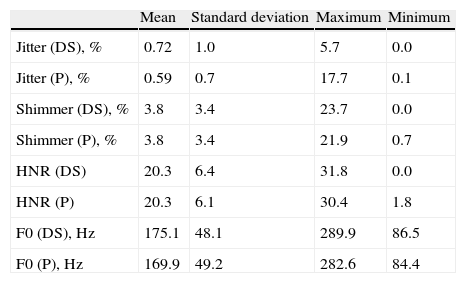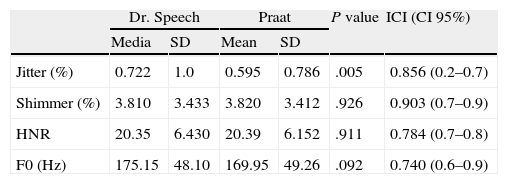The European Laryngological Society (ELS) basic protocol for functional assessment of voice pathology includes 5 different approaches: perception, videostroboscopy, acoustics, aerodynamics and subjective rating by the patient. In this study we focused on acoustic voice analysis.
The purpose of the present study was to correlate the results obtained by the commercial software Dr. Speech and the free software Praat in 2 fields:
1. Narrow-band spectrogram (the presence of noise according to Yanagihara, and the presence of subharmonics) (semi-quantitative).
2. Voice acoustic parameters (jitter, shimmer, harmonics-to-noise ratio, and fundamental frequency) (quantitative).
Materials and methodsWe studied a total of 99 voice samples from individuals with Reinke's oedema diagnosed using videostroboscopy. One independent observer used Dr. Speech 3.0 and the second one used the Praat programme (Phonetic Sciences, University of Amsterdam).
The spectrographic analysis consisted of obtaining a narrow-band spectrogram from the previous digitalised voice samples by the 2 independent observers. They then determined the presence of noise in the spectrogram, using the Yanagihara grades, as well as the presence of subharmonics. As a final result, the acoustic parameters jitter, shimmer, harmonics-to-noise ratio and fundamental frequency were obtained from the 2 acoustic analysis programmes.
ResultsThe results indicated that the sound spectrogram and the numerical values obtained for shimmer and jitter were similar for both computer programmes, even though type 1, 2 and 3 voice samples were analysed.
ConclusionsThe Praat and Dr. Speech programmes provide similar results in the acoustic analysis of pathological voices.
El protocolo de la European Laringological Society (ELS) para la valoración funcional de la disfonía incluye 5 dimensiones: percepción, análisis acústico, videoestroboscopia, aerodinámica y autovaloración del paciente.
El objetivo de este trabajo es correlacionar los resultados obtenidos con el programa comercial Dr. Speech con los obtenidos con el programa gratuito Praat en 2 ámbitos:
1. Espectrograma de banda estrecha (presencia de ruido según Yanagihara y presencia de subarmónicos) (semicuantitativo).
2. Parámetros acústicos de la voz (jitter, shimmer, relación armónico-ruido, frecuencia fundamental) (cuantitativo).
Material y métodosSe estudiaron un total de 99 muestras de voz diagnosticadas mediante videoestroboscopia de edema de Reinke. En este estudio un observador independiente utilizó el Dr. Speech 3.0 y otro el Praat (Phonetic Sciences, University of Amsterdam).
El análisis espectrográfico consistió en obtener un espectrograma de banda estrecha a partir de las anteriores voces digitalizadas por parte de los 2 observadores independientes. Después determinaron la presencia de ruido en el espectrograma siguiendo los grados de Yanagihara y la presencia de subarmónicos. Por último, se obtuvieron los siguientes parámetros acústicos: jitter, shimmer, relación armónico-ruido (HNR) y el valor de la frecuencia fundamental (Fo).
ResultadosLos resultados indican que el espectrograma y el parámetro de perturbación de la frecuencia jitter son comparables en los 2 programas. También es comparable el parámetro de perturbación de la amplitud shimmer, a pesar de haber analizado tanto voces de tipo 1, como de tipo 2 y de tipo 3.
ConclusionesLos programas Praat y Dr. Speech ofrecen similares resultados en el análisis acústico de las voces patológicas.










